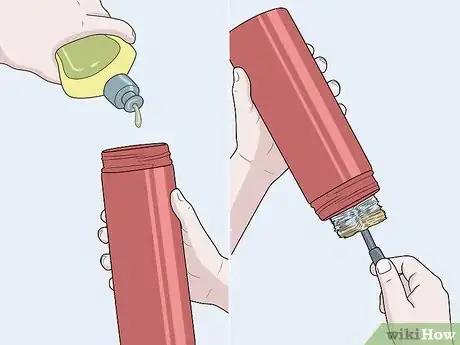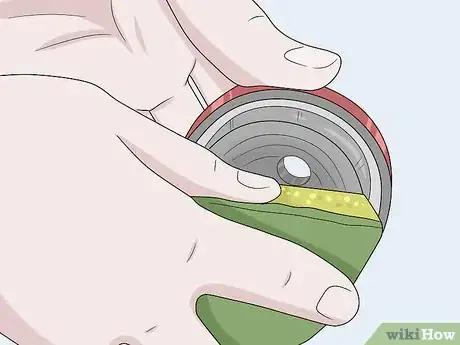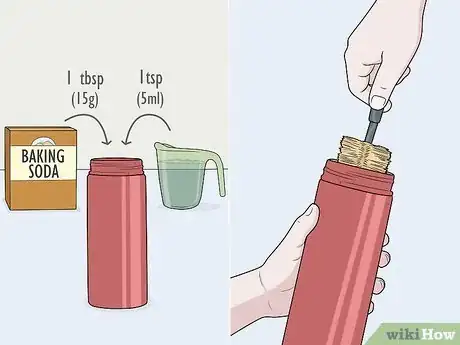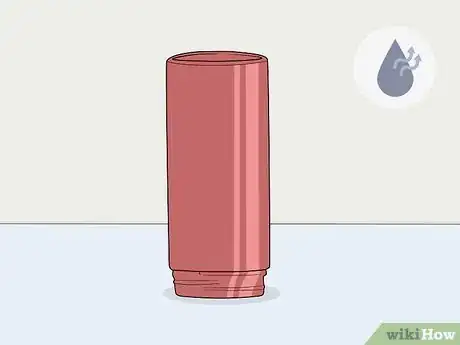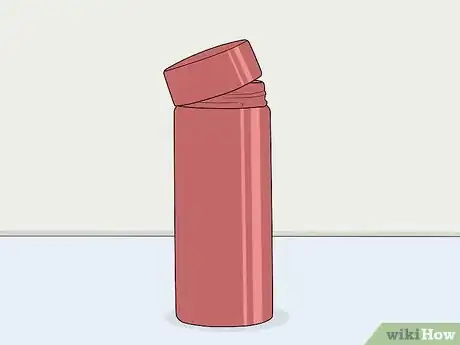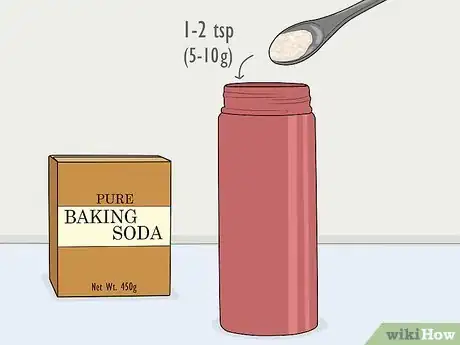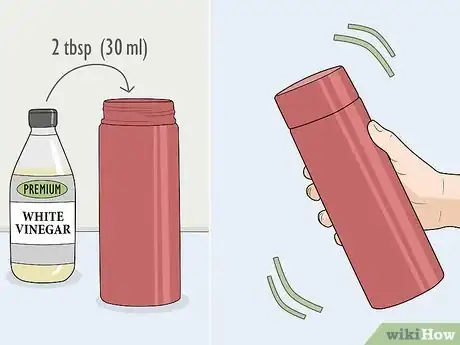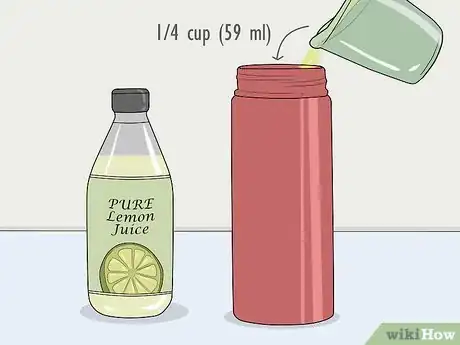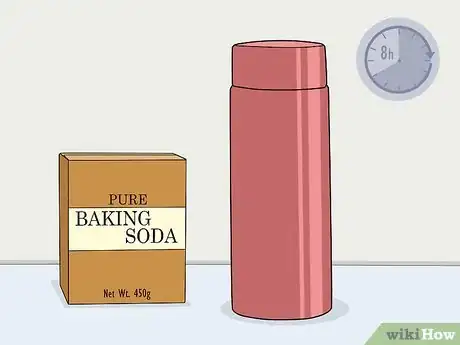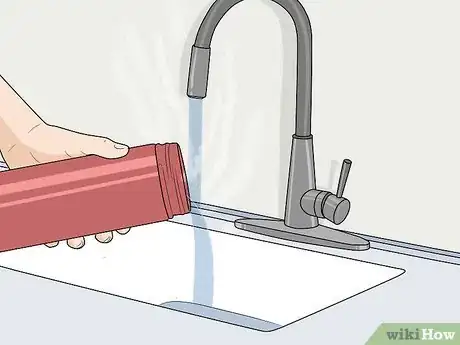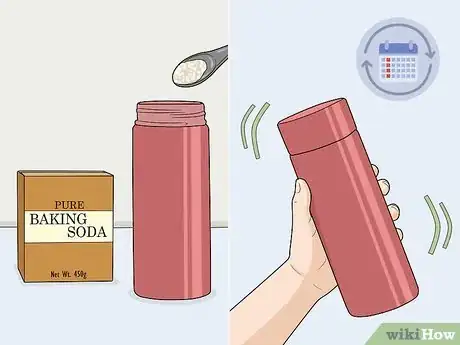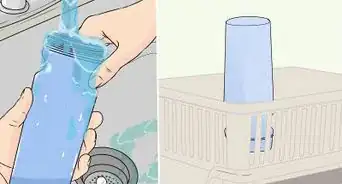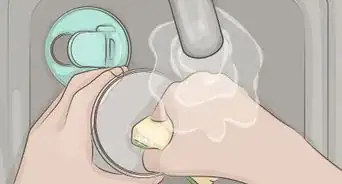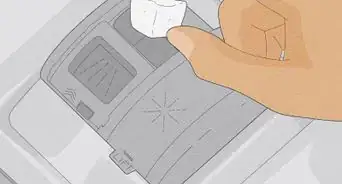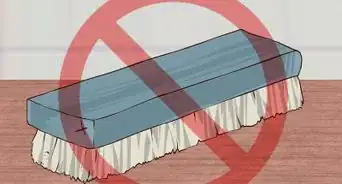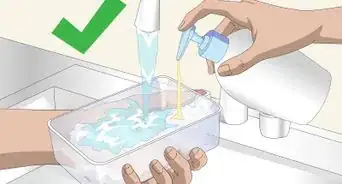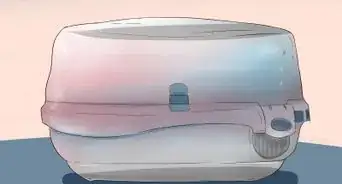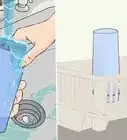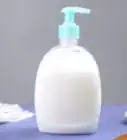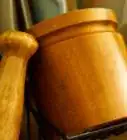This article was co-authored by wikiHow Staff. Our trained team of editors and researchers validate articles for accuracy and comprehensiveness. wikiHow's Content Management Team carefully monitors the work from our editorial staff to ensure that each article is backed by trusted research and meets our high quality standards.
There are 7 references cited in this article, which can be found at the bottom of the page.
wikiHow marks an article as reader-approved once it receives enough positive feedback. In this case, 100% of readers who voted found the article helpful, earning it our reader-approved status.
This article has been viewed 166,065 times.
Learn more...
Vacuum flasks often develop a musty odor over time. Luckily, there are some simple ways that you can get rid of an unpleasant odor in your vacuum flask. Wash your vacuum flask after each use to prevent odors from building up. If this doesn’t help, add baking soda or a baking soda solution to the flask and let it sit. If you’re in a hurry, a quick treatment with baking soda and vinegar should make the flask smell much better!
Things You Should Know
- Wash the flask with dish soap and a bottle brush, disassemble the lid to clean it as well, and scrub the flask with baking soda if it’s stained.
- To deodorize the flask, put 1-2 teaspoons of baking soda inside it, add vinegar, and shake it.
- Let the baking soda mixture sit in your flask overnight to get rid of intense smells, and rinse the flask out the next day.
- Plastics can retain odor and taste of previous contents. While the metal can be cleaned, it is likely not possible to complete remove odors such as milk spoilage smell from contents accidentally allowed to sit and spoil for weeks. The only totally satisfactory resolution is to replace the lid.[1]
Steps
Washing the Flask
-
1Wash the flask with dish soap and a bottle brush after each use. Add a few drops of dish detergent to the flask and then fill it up with warm water. Scrub all around the inside of the flask with a bottle brush. Then dump out the soapy water and rinse the flask 3 or more times to get rid of all the soap residue. Make sure that the water comes out clear.[2]
- Many vacuum flasks manufacturers do not recommend washing the flask in the dishwasher. Check the care instructions to see if the flask is dishwasher-safe so you can simply wash it in the dishwasher after each use.
-
2Disassemble the lid and clean it thoroughly. Take apart any pieces of the flask that come loose, such as the seal on the lid. Scrub these removable parts and all surfaces of the lid with a bottle brush, dish soap, and warm water. Scrape out gunk from the nooks and crannies with a cotton swab or toothpick if needed.[3]
- These areas of the flask can harbor mold if you do not clean them well, so do this every time you clean your flask.
Advertisement -
3Scrub the flask with a baking soda paste if it’s stained. If there are coffee stains inside the flask, mix 1 tablespoon (15 g) of baking soda with 1 teaspoon (5 mL) of water and use it to scrub the inside of the flask. Rub the paste around the inside of the flask with a bottle brush and then rinse the flask thoroughly with hot water.[4]
- For a heavily-stained flask, you might need to repeat this 1-2 more times.
-
4Place the flask upside down to dry for 2-4 hours. After washing and rinsing the flask thoroughly, place it on a drying rack or clean, dry towel to dry. Turn the flask so it is upside down to allow the water to drip out. Place the lid on the drying rack or towel as well. If you took apart the lid, keep the lid parts separated until they are all dry as well.[5]
- If you’re in a hurry, use a lint-free cloth or paper towel to dry the inside of the flask and its parts.
-
5Reassemble and replace the lid loosely after the flask is completely dry. When there is no water left on the flask, turn it right side up. Reassemble the lid if you took it apart. If you want to store the flask for later use, place the lid on it loosely to avoid trapping any remaining odors inside of the flask.
Deodorizing the Flask with Baking Soda
-
1Add 1-2 teaspoons (5-10 g) of baking soda to the flask. Measure out the baking soda and add it to the clean, dry flask. The amount doesn’t have to be precise. A little more or less is fine.[6]
- Baking soda is cheap and easy to find. It’s usually located in the baking aisle of grocery stores.
-
2Add vinegar and shake the flask for more intense cleansing action. Pour about 2 tablespoons (30 mL) of vinegar into the flask and place the lid back on it. Then, shake the flask for about 10-15 seconds. Remove the lid and dump the vinegar and baking soda out after you finish shaking.[7]
- The vinegar and baking soda will react with each other and begin to fizz. This will help cleanse the inside of the flask and eliminate odors.
-
3Use 1⁄4 c (59 mL) of lemon juice for an alternative to vinegar. If you don’t have or don’t want to use vinegar, lemon juice is a good alternative. Pour in the lemon juice with the baking soda, replace the lid, and shake the flask vigorously for about 30 seconds. Then, remove the lid and dump out the remaining baking soda and lemon juice solution.[8]
- The combination of lemon juice and baking soda should eliminate any foul odors and you may even end up with a lemony-fresh smelling flask.
-
4Let the baking soda sit in the flask overnight if it’s very musty. Don’t add anything else to the flask. Replace the lid and leave the baking soda in the flask overnight or for 8 hours. You can do this instead of adding vinegar or lemon juice. This will help to combat an extra musty smelling flask.[9]
- You can leave the baking soda in the flask for longer than 8 hours. Just make sure to rinse it out before you use it again! Use a sticky note that says something like “Rinse!” and stick it to the flask so you remember to rinse it out.
-
5Rinse the flask out before you use it again. After treating the flask with baking soda only, baking soda and vinegar, or baking soda and lemon juice, rinse it thoroughly with warm water. Make sure to get all of the baking soda out of the flask before you use it again or your beverage will taste funny. Watch for the water to run clear as you rinse the flask.[10]
-
6Repeat the baking soda treatment once a week. Regular maintenance will help prevent odors from building up in the flask. You can give the flask a baking soda treatment once per week or any time it starts to smell a little musty.
Community Q&A
-
QuestionIs it best to store a flask open, in other words without the stopper?
 Community AnswerYes, because if there is even the slightest moisture, it will smell overnight.
Community AnswerYes, because if there is even the slightest moisture, it will smell overnight. -
QuestionDo teabags work?
 Community AnswerNo, brewing tea and adding it to the flask will only make the odor worse. It's best to remove the buildup that's causing the odor using a combination of washing and treating with baking soda.
Community AnswerNo, brewing tea and adding it to the flask will only make the odor worse. It's best to remove the buildup that's causing the odor using a combination of washing and treating with baking soda.
Warnings
- Avoid using bleach, abrasive cleansers, or harsh chemicals to clean your vacuum flask. These can cause damage to the inside of the travel flask and may make you sick if they leave residue behind.⧼thumbs_response⧽
Things You'll Need
Washing the Flask
- Dish soap
- Bottle brush
- Baking soda
- Cotton swab or toothpick
- Drying rack or clean, dry towel
Deodorizing the Flask with Baking Soda
- Baking soda
- Vinegar
- Lemon juice
References
- ↑ https://issuu.com/usuextension/docs/food_storage_booklet2_49bc3ab844f0dc/s/10352744
- ↑ https://www.youtube.com/watch?v=z0g0TTFAE0c&feature=youtu.be&t=18
- ↑ https://www.southernliving.com/news/mold-in-travel-mug
- ↑ https://www.goodhousekeeping.com/home/cleaning/tips/a2410/remove-coffee-odor-oct01/
- ↑ https://www.southernliving.com/news/mold-in-travel-mug
- ↑ https://www.youtube.com/watch?v=z0g0TTFAE0c&feature=youtu.be&t=22
- ↑ https://www.goodhousekeeping.com/home/cleaning/tips/a22190/coffee-cup-cleanup-heloise/
- ↑ https://www.goodhousekeeping.com/home/cleaning/tips/a22190/coffee-cup-cleanup-heloise/
- ↑ https://www.youtube.com/watch?v=z0g0TTFAE0c&feature=youtu.be&t=22
About This Article
If you need to remove a musty smell from your vacuum flask, try washing it with soapy water. Mix a few drops of dish detergent with water, then scrub the soapy water around the inside of the flask with a bottle brush. You should also take apart the lid, including the seal, and clean each part separately, since mold may gather over time. If washing the flask fails to remove the smell, try a baking soda and vinegar mix. Add 2 teaspoons of baking soda and 2 tablespoons of vinegar to the flask. Leave the baking soda in the flask for 8 hours, then rinse it out. For tips on how to remove coffee stains with a baking soda paste, keep reading!
